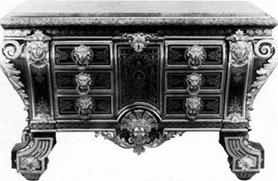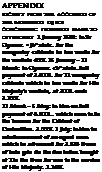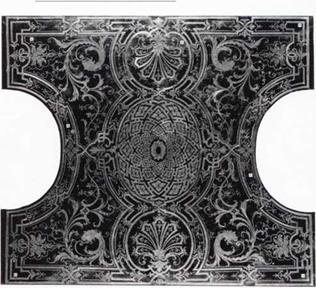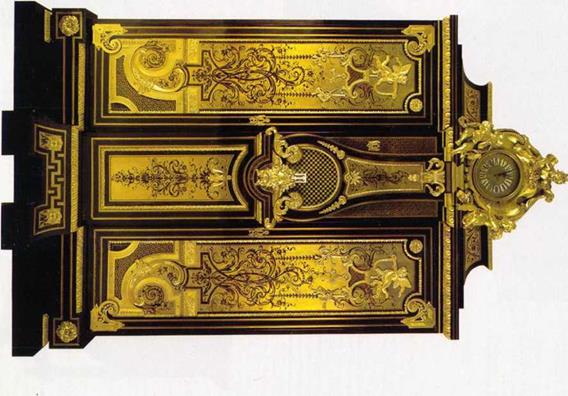c. 1639-1715: ЁВЁЫЕГГЕ ORDINAIRE DU ROI
|
B |
orn in the Netherlands in 1639, Oppenordt was the son of Henri Oppen Oordt and Marie Tendart. He established himself in Paris at the beginning of Louis XIV’s reign and worked in the privileged quarter of the Temple, the area where ebenistes not yet become master could practise their craft. In 1679 he was naturalized. His papers described him as compagnon menuisier en ebene… native of the town of Guelder, professing the Catholic religion’. In 1684 Oppenordt obtained lodgings at the Louvre and began work in the service of the Batiments du Roi.
In early 1684 he was paid 3.600 livres for ‘twelve marquetry cabinets which he made for His Majesty’s medals, at 300 livres each’. These cabinets were installed at Versailles in niches in the Cabinet des Curiosites also called the Cabinet des Medailles and were complemented by a sumptuous bureau (for a sum of 6.500 livres) and four other cabinets in king – wood. Lunsingh Scheurleer has shown that the twelve marquetry cabinets, for a long time identified as the celebrated ‘armoires a chutes de medailles’ at Versailles [32]. were completely different. This is confirmed by Felibien’s description of 1685: ‘Twelve armoires or individual cabinets only breast high… placed in the niches and embrasures… and gilt and enriched with ornamentation and here and there figures of children forming terms.’ The great desk was designed by Berain. who. with Clairin. supervised the engraving of its marquetry. Felibien described it as ‘a large table fitted with drawers and made in the form of a desk’. As yet not one of these pieces has been traced, but various engravings by Berain give an idea of its style, as well as the description in the inventory of 1718: ‘567: A large octagonal table in marquetry of brass and pewter on a tortoiseshell ground. 6 pieds 5 pouces in length and 4 pieds in width, the top covered with velvet with a gold and silver braid. All round the table are drawers fitted with locks. It is supported on eight square tapering legs enriched with gilt-bronze mounts. Between the stretchers is placed a small cupboard with drawers in the same marquetry and ornamentation as the rest.’ (Arch. Nat. О’ЗЗЗб.) The bronze mounts for the desk were modelled by Le Hongre and Charmenton and cast by Le Negre.
In 1685 Oppenordt was paid 240 livres ‘for compartments made for two bureaux for His Majesty’s Petit Cabinet’. These were probably the marquetry panels made for a bureau recently identified as from Louis XIV’s Cabinet de la Poudre at Versailles [12].
Between 1684 and 1686 Oppenordt made the parquet for Louis XIV’s Petite Galerie at Versailles. During these years he was also working for Louvois. making two pietra-dura cabinets for him which are mentioned in the inventory drawn up after the latter’s death in 1693. A drawing by Berain for a cabinet in pietra-dura with the arms of Louvois is probably the only surviving evidence we have of either of these pieces. It once again confirms the collaboration between Berain and Oppenordt [9].
The Swedish envoy Cronstrdm mentions in a letter in 1693 that Berain habitually used his team of craftsmen for ebenisterie commissions he had received: ‘I do not know whom to recommend to make tables and gueridons. Cucci is excellent. On the other hand Berain has admirable designs and skilled craftsmen …’ In the author’s opinion this refers to Oppenordt. and therefore one may attribute to him two works that were designed by Berain: the sarcophagusshaped commode in the Wallace Collection [10]. after an engraving by Berain which can be dated, according to Jerome de la Gorce. to c. 1690-95. and the flooring

 in tortoiseshell marquetry of the royal coach in Stockholm. executed in Paris in 16% (11]. In both cases the composition of the marquetry, made of small arabesques delineated by handwork, is very different from Boulle’s. Moreover. Cronstrom. when referring to the floor of the coach which was made in Paris, makes no mention of either Cucci or Boulle. both of great contemporary renown. He would surely have boasted of using their services if this had been the case: They are starting to make the body of the coach, it will cost 600 livres. It is admittedly an enormous price, but the quality and the renown of the ‘menuisier du roi’ accounts to a large extent for this price* (letter, 14 August 16%). This reference to the ‘menuisier du roi’ definitely applied to Oppenordt, who in the 1690s continued in the service of the Batiments du Roi but received no further commissions, all projects being brought to a halt by the lack of funds due to the War of the League of Augsburg. He could therefore concentrate on his private clientfcle.
in tortoiseshell marquetry of the royal coach in Stockholm. executed in Paris in 16% (11]. In both cases the composition of the marquetry, made of small arabesques delineated by handwork, is very different from Boulle’s. Moreover. Cronstrom. when referring to the floor of the coach which was made in Paris, makes no mention of either Cucci or Boulle. both of great contemporary renown. He would surely have boasted of using their services if this had been the case: They are starting to make the body of the coach, it will cost 600 livres. It is admittedly an enormous price, but the quality and the renown of the ‘menuisier du roi’ accounts to a large extent for this price* (letter, 14 August 16%). This reference to the ‘menuisier du roi’ definitely applied to Oppenordt, who in the 1690s continued in the service of the Batiments du Roi but received no further commissions, all projects being brought to a halt by the lack of funds due to the War of the League of Augsburg. He could therefore concentrate on his private clientfcle.
In 1694 Oppenordt made a pilgrimage to Italy. From 1691 to 1714 there is no further mention of him in the accounts of the Batiments Royaux except for his annual retainer of 30 livres. He died in 1715.
[10j Sarcophagus-shaped commode, c. 1695. Following an engraving by Beram, it is here attributed to Oppenordt who collaborated on several occasions with Beram. It featured in the M. de Billy sale in 1784, lot 170, then in the sale of the dealer Dubois in 1785, lot 213. (Wallace Collection, LondonI
BIBLIOGRAPHY
H. Vial. A. Marcel and A. Girodie: Les Artistes decorateurs du bois
Lunsingh Scheurleer: ‘A la recherche du mobilier de Louis XIV’, Antologia di belle arti, nos 27-28. 1985 Alfred Marie: Mansart a Versailles. Paris. 1972. vol. II. pp. 407-17
Jean-Nei-ёе Ronfort: ‘Versailles el le bureau du roi’. L’Estampille. April 1986 Arch. Nat. Min. Cent. Et/LXXV. 533 and 534 (Distribution of furniture belonging to the Louvois estate] Jdrome de la Gorce: Berain. Paris. 1987
18 March – 9 December: to him for the parquet which he has made for the Galeric du Petit Appartemcnt of His Majesty. 9.000L
14 April – 19 November: to him for the bureau which he has had made for the Cabinet of Curiosities 3.500L 21 October 1685: to Openor. another tfb£niste. his payment for
2 models of door-frames which he has made for His Majesty’s Petite Calcrieat Versailles. 200L 25 July: to Jean Oppenor, £b£niste. for compartments made for 2 bureaux in His Majesty’s Petit Cabinet 2401.
31 December 1684 – 11 March 1685: to Openor. tfb&ustc. full payment for marquetry works he has made for the repair of 12 medal cabinets for the King 1.632L
23 November 1686:. made over 632L to the said Oppenort. 6bcniste. payment for 4 cabinets in bots violet and other works which he made for His Majesty’s (Cabinet des Medailles December to Oppenor. ^Wniste. for marquetry pieces to store medals at the chateau 180L
15 December: to Oppenort. 6b£nistc. for 4 cabinets in bois violet and other works which he made for the Cabinet des Medailles. 632L
3 February -10 March: to Oppenor. ^Ы-niste. for 11 pieces of red sandalwood weighing 2.171 livres which he delivered to the store, at 12s the livre. 1.302L 10 March: to him for the parquet in compartments of different colours which he made for the Petite Galerie at Versailles. 2.000L
8 February 1688: to Oppenor.

&еш*Іс. for work in marquetry anti gilt-brass which he made for Monseigncur Ic Due dc Bourgogne. 360L 28 March: to Sr Oppenort, cbenistc. for 10 drawers in oak made and fitted to take trays of agates in the Cabinet des
Metallic*. Ж
[Comptesdes Bailments du Rot. published by Guiffrey. vols. И and lll|
II1J Parquet with tortoiseshell and brass marquetry from the Royal Swedish coach, made in Pans in 1696 by the "menutster du roi‘, certainly Oppenordt, after designs by lleram, at a cost of 600L. (Royal Palace, Stockholm; Livrustkammaren)
 1121 Bureau brise, the marquetry work almost certainly made by Oppenordt in 1685. It is described in the inventory of Louis XIV’s collections in 1718 as number 561, with its pendant, since altered. (Metropolitan Museum of Art, New York)
1121 Bureau brise, the marquetry work almost certainly made by Oppenordt in 1685. It is described in the inventory of Louis XIV’s collections in 1718 as number 561, with its pendant, since altered. (Metropolitan Museum of Art, New York)
|
|
Andre-Charles


